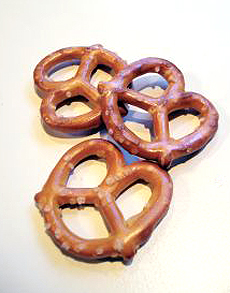 The original pretzel shape denoting a child’s arms folded over the heart in prayer. It was called a brachiola or “little arms.” Photo by Cindy Kalamajka | SXC. The original pretzel shape denoting a child’s arms folded over the heart in prayer. It was called a brachiola or “little arms.” Photo by Cindy Kalamajka | SXC.
November 2010
|
 |
Pretzel History Timeline
15 Centuries Of Delicious Crunch
Thanks to H. K. Anderson for a large portion of this historic timeline of pretzels. And thanks to the unknown monk who created the pretzel.
Pretzel History
| 610 C.E. |
Monks in Southern France or Northern Italy twisted and baked scraps of dough as a reward/bribe to children who had memorized their Bible verses and prayers. The shape (see photo above) represented the monk’s concept of a child’s arms folded in prayer. The monks called this soft, baked dough a "pretiola," Latin for “little reward.” The word evolved into the Italian “brachiola,” which means “little arms.” |
700 To
1100 |
The Pretiola journeyed through the French and Italian wine regions, crossed the Alps, traveled through Austria, and arrived in Germany, where it became known as the Bretzel or Pretzel. |
| 1100s |
In medieval times, merchants traveling to the Frankfurt Fair risked being robbed by bandits. In order to safeguard the tradesmen, the townsmen would ride out to greet them, bringing refreshments of wine and carrying pretzels on their spears, called Geleit-pretzels or “escort pretzels.” |
| 1200s |
Over time, pretzels became associated with both Lent and Easter. Simply made from flour, salt and water and its shape denoting prayer, pretzels became a midday meal throughout the Lenten season. They also served as a fasting food for other occasions, Eventually, pretzels became an easter treat, the recipe enhanced with eggs, cheese, and butter and spices. These “deluxe” pretzel were hidden on Easter morning, just as eggs are hidden today. |
| 1300s |
The pretzel’s three holes are said represent the Holy Trinity: Father, Son and Holy Spirit. Pretzels are thought to bring luck, prosperity and spiritual wholeness. The wedding phrase “tying the knot” got its start when a pretzel was used to tie the knot between two prominent families. The loops of the pretzel were said to stand for everlasting love. |
| 1652 |
According to the Encyclopedia of American Food and Drink, pretzels most likely arrived in America with Dutch settlers. One story from 1652 says that a settler named Jochem Wessel was arrested for using scarce white flour to make pretzels to sell to Native Americans, who loved them, while fellow settlers were eating bran flour.
|
| 1700s |
A breakthrough! Prior to now, pretzels were served soft. But a baker fell asleep while tending to a batch of baking pretzels. Upon waking he restarted the fire in the hearth, which over-baked the pretzels. He thought he had ruined the batch but in the process of throwing them out he tasted one. With all the moisture baked out, it was crunchy and satisfying; he realized he was on to something big! The “dry” pretzels had a long shelf life and didn’t go stale in a day like soft pretzels. |
| 1800s |
The pretzel became well-known with the German immigration of the 1800s. Their snack was called a “bretzel”; in America it became known as a pretzel. People gathered at pretzel shops to chat while enjoying a fresh-baked, hand-twisted pretzel. The first mention of “pretzel" in print in America is circa 1824; the first commercial pretzel bakery in the United States, Sturgis Pretzel, was established in in Lititz, Pennsylvania, in 1861 by Julius Sturgis and Ambrose Rauch. It’s still in business. |
| 1933 |
The modern age of the pretzel began with the introduction of the automatic pretzel-twisting machine. This innovation enabled mass production, made pretzels available to people in all parts of the country, and helped the fledgling industry grow. |
| 1983 |
Pennsylvania State Representative Robert S. Walker initiated the celebration of National Pretzel Day. The practice faded, but Pennsylvania’s current Governor Ed Rendell relaunched the practice: now April 26th is celebrated as National Pretzel Day. |
| Today |
Today, pretzels are a favorite American snack. The simple treat made from flour, water, salt and yeast is still available in its original soft twisted form (here’s a soft pretzel recipe). But the majority of pretzels sold owe thanks to that sleeping baker: they’re crunchy, thin, thick or twisted; plain, flavored, filled or chocolate covered; made of white flour, sourdough, whole wheat or multigrain; enjoyed plain or with mustard or other condiment/dip. They’re flavored with barbecue seasonings, cheese, honey mustard, jalapeño, onion and other favorites. What will the next evolution be? We don’t know, but we look forward to it! |
Go To The Article Index Above
READ MORE REVIEWS OF OUR FAVORITE
SNACKS |

|




